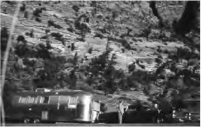
A Photo Album,
with Commentary
JUST AFTER my father’s death in 2008, my brother, Ron, digitized roughly 500 of my parents’ colour slides taken in the 1950s and 1960s, and sent them to each family member on a pair of DVDs. I copied the DVDs into the picture folders in both of my computers, one of which, the laptop, regularly sits on the counter that separates the kitchen of my house from the dining room.
The slides Ron digitized had been languishing in my parents’ basement for 40 years, relics of bypassed technology and social habits—in this case, the interminable slide shows that most children in that era had to suffer through after family trips and holiday seasons. Most of the pictures I’d seen many times before, but always socially and without leisure, projected on a fold-up screen with the pacing determined by someone else’s agenda, usually— okay, always—my father’s.
Ron had digitized just 500 out of the 2000 or so slides in the basement, and for a good reason. The other 1500 were scenery, which the introduction and wide distribution in the early 1950s of 35-millimetre colour film and improved lenses made more attractive to photograph. That’s also why many of the 500 slides that made my brother’s cut feature family members photographed off in the distance, tiny foreground authenticants to the scenery my father loved. Nearly all the slide shows I was subjected to as a kid were narratives about where and how my parents holidayed, which is to say, look at all those bloody trailers parked by that lake and how much do you think they cost? Or how about those mountains in the distance shimmering with light, and gee, look at that bank of cloud hanging over that lake, is that a rainbow?
I was interested, then as now, in people. When I look at a photograph, I want to know what’s going on in people’s minds, posed or unguarded. During my father’s slide shows, I peppered him with questions about who they travelled with or who they met when they got to their destination, and what they talked about, what they were like—until I was told to shut up. Some dopey geographical detail 20 miles in the distance that we’d never get close to, and which would probably be logged or burned within a decade, interested me not in the least, particularly when it was my old man supplying the narrative and my fellow British Columbians administering the destruction.
So really, it wasn’t the slides shows I hated all those years ago, it was scenery. My father loved scenery. Once he had the money and the leisure, he perched himself and his homes on the shores of lakes or atop hills with vistas of river valleys so he could view the scenery, spout platitudes about it, and enumerate the development possibilities that would sully its beauty. It saddled me with a lifelong dislike for the far distance. Or maybe it is the onslaught of platitudes that always seems to spout from people’s mouths while they’re standing in front of a scenic view.
It occurred to me while I was watching these same photographs scrolling digitally across my laptop screen for the first time that I had never before had the luxury of being able to study their contents on any schedule of my own devising. If you sat a colour slide in front of a projector too long, the projection bulb would fry the image, and so it was move on, move on, and don’t dawdle or reflect. Unless my father was photographing some boring vista, that was pretty much his general ethos in those years.

I was able to watch this new slide show because my laptop has a screen saver that chooses photographs at random from the machine’s picture folder, and runs them on a more or less endless loop. Thus, almost 50 years after my father’s photographs were taken, I can watch a twenty-first-century version of those old slide shows, this time on a much more watchable screen size of 9 x 11 inches, and with a pacing that anyone sitting at the kitchen counter can control simply by manipulating the keyboard’s forward and backward arrows.
After watching several hundred always-unique yet utterly connected slide shows on my kitchen laptop, I’ve discovered something important and ineluctably true about my parents and about my family that I missed utterly while I was in the middle of the story. I missed it, I suppose, because I wanted the narrative to be about me and not family, or maybe I just missed it because I was young and stupidly impatient.
Here’s the thing: Hartley Fawcett and Rita Surry, individually and together, based on the only documentary evidence that exists now that they’re not around to interfere with their nostalgic and possibly disappointed testimony, were, despite the protracted war they waged against one another, happy and comfortable people, the alpha male and female of several sizable social and economic communities they were part of.
Now I hear the objections: these are photographs, many of them posed, and all of them at least subject to the formalities of self-projection. Sure, that’s true. But as my father used to say while he was trying to inflict his Philosophy-O-Life on my unwilling ears, “As a Man Thinketh, So He Is.” What he meant by this was that an important fuel for happiness is its conscious projection as well as its conscious pursuit.
So let’s turn on the projector and see what the pictures have to say.